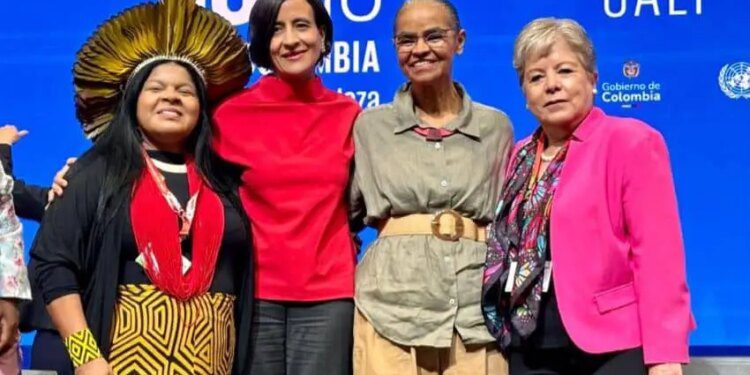Environment Minister Alicia Bárcena described her plans to expand Mexico’s protected lands through partnerships with local governments and Indigenous communities at the Conference of the Parties on Biological Diversity (COP) in Cali, Colombia.
The world’s leading biodiversity conference, COP’s 16th edition has been dubbed “The People’s COP,” as it seeks to elevate the role of Indigenous peoples and local communities as guardians of nature.
114 environment ministers from around the world gathered at #COP16Colombia to make #PeaceWithNature and meet the targets of the Kunming-Montreal Global Framework.
The will is strong, but it needs to be stronger to stop the loss of biodiversity on Earth 🌎🤝💚. pic.twitter.com/njqw2NaqiY
— COP16 COLOMBIA 🇨🇴 (@COP16Oficial) October 30, 2024
Speaking at the conference on Tuesday, Bárcena said that Mexico is committed to implementing urgent measures to protect 153 million hectares of land and sea by 2030, equivalent to 30% of Mexican territory, a goal known as “30×30.”
“In Mexico, we have 232 Natural Protected Areas, which today represent 99 million hectares, and by the year 2030, we have to protect 30.8 million hectares of land and 19.6 million hectares of marine areas. It is an immense task,” Bárcena said.
“We no longer have the territory to be able to create the reserves that we did in the past, like Sian Ka’an,” Bárcena continued. “Therefore, we have to act on what we have today. And that is what we are proposing along with Chile … conservation measures known as OEMCs.”
The acronym OEMC stands for other effective area-based conservation measures, which refers to “a geographically delimited area that is not a protected area, which is managed in such a way as to achieve positive and long-term results for the in situ conservation of biodiversity.”
In her COP16 speech, the minister stressed that applying environmental justice is “a big challenge,” particularly for Mexico. (Alicia Bárcena/X)
In her speech, the minister stressed that applying environmental justice is “a big challenge,” particularly for Mexico. Two major obstacles mentioned by Bárcena are the lack of prevention and justice mechanisms to confront environmental crimes by transnational corporations, and the illegal management of natural resources by organized crime.
Mexico, Latin America and the Caribbean at COP16
Latin America and the Caribbean are home to six of the 10 most environmentally diverse countries on the planet — including Mexico. The region has around 60% of the world’s biological diversity and a third of the planet’s fresh water. Mexico alone is home to around 12% of the world’s biodiversity.
Of the 196 countries that make up the list of parties attending COP16, however, only 35 submitted complete biodiversity action plans. In Latin America, only Colombia, Mexico, Cuba and Surinam submitted one.
Mexico’s biodiversity action plan
Mexico’s proposal outlines its strategies and actions aimed at meeting the 23 Kunming-Montreal performance targets for 2030. These include participation of Indigenous peoples, control of invasive species, ecosystem restoration and sustainability in agriculture and fisheries. Overall, the strategy encompasses 48 goals.
“It was a very long process involving many workshops with the federal administration, state governments, representatives of Indigenous peoples, academia and NGOs,” Esiquio BenĂtez, head of international cooperation and implementation at the National Commission for the Knowledge and Use of Biodiversity (Conabio) told the news outlet Animal PolĂtico.
Ahead of the event, Bárcena said that following COP16, her ministry will assess the ambition and viability of the 48 goals based on available funding.
With reports from Mongabay, La Jornada and El PaĂs
Source link : http://www.bing.com/news/apiclick.aspx?ref=FexRss&aid=&tid=6722a6ec912d41cbacd42199c13edfe1&url=https%3A%2F%2Fmexiconewsdaily.com%2Fnews%2Fmexico-conservation-cop16%2F&c=13196579768876722598&mkt=en-us
Author :
Publish date : 2024-10-30 09:48:00
Copyright for syndicated content belongs to the linked Source.












